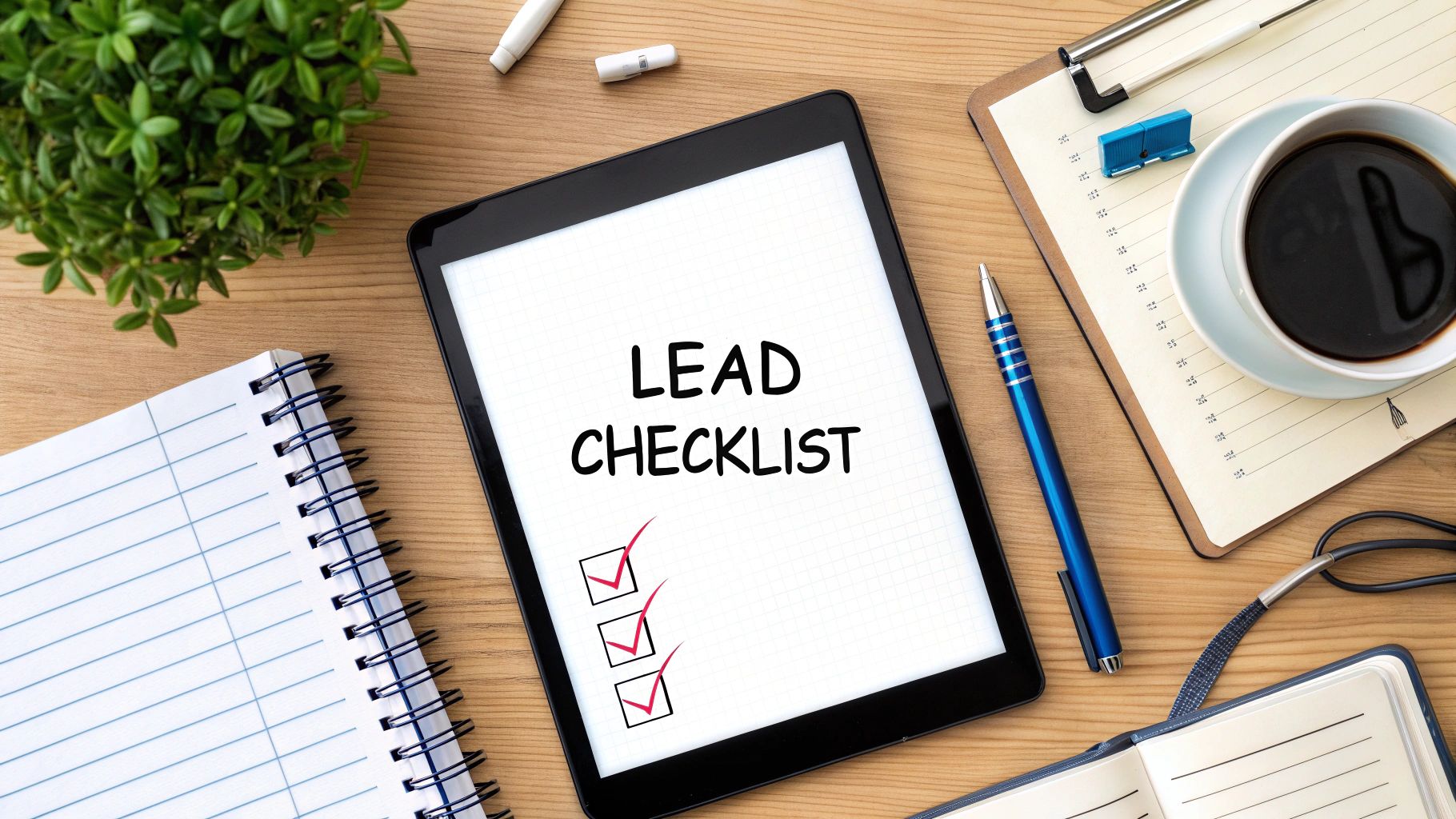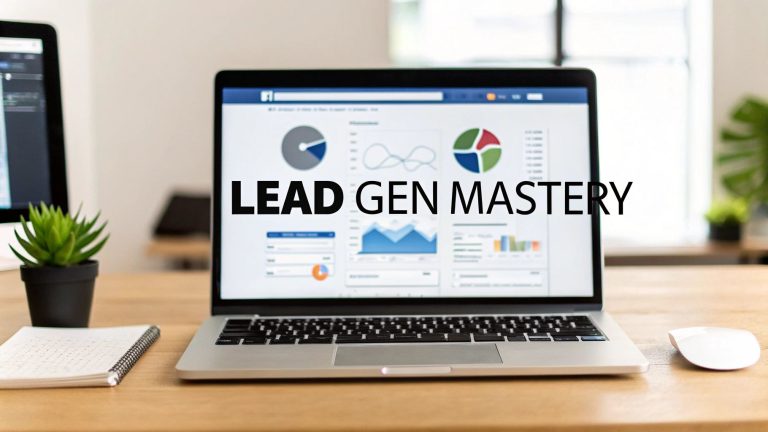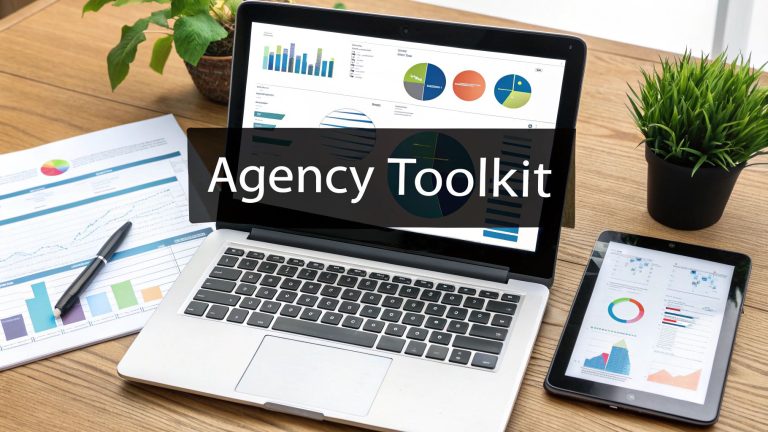Your Ultimate 7-Point Lead Qualification Checklist for 2025
Stop Wasting Time: Why Your Sales Team Needs a Smarter Way to Qualify Leads
In sales, the line between a future loyal customer and a dead-end conversation is drawn at qualification. Chasing every lead that comes your way is a surefire path to burnout and missed quotas. The real secret to boosting sales efficiency and revenue isn't working harder; it's working smarter. This means implementing a systematic, repeatable process to identify which prospects have a genuine potential to buy.
A robust lead qualification checklist acts as your sales team's GPS, guiding them away from time-wasting detours and directly toward the most promising opportunities. Without it, you're investing precious resources into conversations that were never destined to convert. This comprehensive guide provides a detailed 7-point checklist, moving beyond basic frameworks to give you a multi-faceted strategy for identifying and prioritizing high-quality leads.
We'll explore established methodologies like BANT and MEDDIC, introduce data-driven fit scoring, and emphasize the critical need to assess the competitive landscape. Get ready to refine your process, focus your efforts, and build a pipeline filled with genuinely qualified prospects.
1. Budget (BANT Framework)
The "B" in the classic BANT framework stands for Budget, and for good reason. It’s the foundational element that determines whether a deal is viable or merely wishful thinking. Qualifying a lead's budget involves more than just asking if they can afford your solution; it’s about uncovering their entire financial reality. This crucial step in any robust lead qualification checklist prevents sales teams from wasting valuable time on prospects who lack the financial capacity to become customers, ensuring resources are focused on opportunities with a genuine chance of closing.

How to Uncover a Prospect's Budget
Successfully navigating the budget conversation requires tact and strategy. Instead of a direct "What's your budget?" which can be off-putting, guide the conversation to reveal the financial landscape. For instance, IBM, the originator of BANT, uses budget qualification to slot enterprise clients into different sales tracks, tailoring the approach based on financial readiness. Similarly, HubSpot uses initial budget inquiries to route leads to either self-service funnels or high-touch enterprise sales teams.
The goal is to understand if a formal budget exists or if it needs to be created. This distinction is vital. A pre-approved budget means the company has already acknowledged the need and allocated funds. If one needs to be created, your role shifts to helping your champion build a business case to secure those funds. Understanding this process is a key part of your qualification efforts. For more insights on how budget parameters can shape lead stages, you can explore the specifics of what defines a Marketing Qualified Lead (MQL).
Actionable Tips for Budget Qualification
To integrate this effectively, consider these practical approaches:
- Ask About Ranges: Instead of a precise number, ask, "Typically, for a solution like this, our clients invest between $X and $Y. Does that fall within the range you were anticipating?" This opens the door for a more comfortable discussion.
- Investigate Past Purchases: Inquire about their previous investments in similar tools or services. Ask, "What have you invested in the past to solve similar challenges?" This provides a historical baseline for their spending habits.
- Focus on ROI: Shift the conversation from cost to value. Present clear ROI calculations showing how your solution generates revenue or creates savings, helping them justify the expenditure internally.
- Map the Approval Process: Ask directly, "Who else besides you would need to be involved in approving a purchase of this size?" This identifies the financial decision-makers and reveals the internal hierarchy.
2. Authority (Decision-Making Power)
The "A" in the BANT framework, Authority, is a critical gate in the sales process. Qualifying for authority means confirming whether your contact has the power to make a purchase decision. Simply put, you need to know if you're speaking with the person who can sign the check or if you're working with an influencer, champion, or gatekeeper. Overlooking this step in your lead qualification checklist can lead to endless sales cycles where deals stall because your proposal never reaches the actual decision-maker, wasting resources on conversations that can't convert.

How to Identify Decision-Making Authority
Identifying the true decision-maker requires more than a simple question; it involves mapping the organizational hierarchy and understanding internal politics. For instance, Oracle’s enterprise sales teams make it a priority to map C-suite decision-makers and their reporting lines early in the qualification process to ensure high-level buy-in. Similarly, Microsoft’s account-based selling strategies often focus on engaging the "economic buyer" from the outset, the individual with final P&L responsibility.
This process, emphasized in methodologies like the Challenger Sale, isn't about dismissing your initial contact. It's about collaborating with them to navigate their organization. Your contact can be a powerful champion, but they need to be equipped to sell your solution internally to the person or committee with ultimate signing power. As Salesforce demonstrates with its multi-threading approach, connecting with multiple authority figures and influencers simultaneously creates a stronger, more resilient path to closing the deal.
Actionable Tips for Authority Qualification
To effectively integrate authority qualification into your process, use these strategies:
- Ask About the Process: Frame your questions around the company's typical evaluation process. Ask, "Who else on the team is usually involved in reviewing and approving new solutions like this?" This is less direct and more collaborative.
- Leverage Professional Networks: Use LinkedIn to research the company’s organizational structure. Identify potential C-level executives, department heads, and VPs who logically fit the profile of an economic or technical buyer.
- Request a Broader Audience: Once you've established value with your initial contact, suggest a group presentation. Say, "To ensure we address everyone's questions, it might be helpful to schedule a brief call with the broader decision-making team. Who should we invite?"
- Distinguish Buyer Types: Identify both the economic buyer (who holds the budget) and the technical evaluator (who assesses the solution's fit). You need a "yes" from both to move forward, so tailor your communication accordingly.
3. Need (Pain Points and Requirements)
Identifying a prospect's Need is the cornerstone of any successful sales process and a non-negotiable part of a comprehensive lead qualification checklist. This goes far beyond a simple desire for a new product; it involves pinpointing the deep-seated business problems, operational challenges, or untapped opportunities that your solution directly addresses. Without a compelling need, there is no urgency and no reason for a prospect to invest their time, resources, or political capital in making a change. This is where methodologies like SPIN Selling and consultative selling shine, as they focus on uncovering and amplifying this core business pain.

How to Uncover a Prospect's Need
Uncovering genuine need requires skilled questioning that guides the prospect from surface-level issues to the quantifiable business impact of those problems. For example, Slack's qualification process excels at digging into communication bottlenecks and collaboration friction within remote or distributed teams, making the pain of inefficient workflows tangible. Similarly, Shopify qualifies leads by identifying the limitations of their current e-commerce platforms, such as an inability to scale or a lack of crucial marketing integrations, thereby creating a clear business case for migration.
The objective is to understand both explicit needs (what the prospect says they want) and implicit needs (the underlying problems they may not have fully articulated). Transforming an implicit pain point into an explicit, urgent problem is the key to creating momentum in a deal. A foundational understanding of this principle is crucial, and you can explore this concept further by reading about the core tenets of what lead qualification is and why it matters.
Actionable Tips for Need Qualification
To master need identification, integrate these proven tactics into your discovery calls:
- Use Discovery Questions: Employ open-ended questions like, "What is the biggest obstacle preventing your team from hitting its goals?" or "If you could wave a magic wand and fix one thing about your current process, what would it be?" to uncover both explicit and implicit pains.
- Quantify the Business Impact: Once a problem is identified, quantify it. Ask, "How much time is your team losing each week due to this issue?" or "What is the estimated revenue impact of this inefficiency?" This translates a problem into a business case.
- Understand the Status Quo: Investigate why their current solution is no longer sufficient. Questions like, "What has changed in your business that makes your current approach unsustainable?" help create urgency.
- Validate Needs Across Stakeholders: A need identified by one contact may not be a priority for the decision-maker. Confirm the pain point with multiple stakeholders to ensure organizational alignment and build internal consensus.
4. Timeline (Urgency and Decision Timeframe)
The "T" in BANT and a critical component in other frameworks like MEDDIC, Timeline determines when a prospect needs to have a solution in place and what is driving that urgency. It’s the element that separates an active opportunity from a passive inquiry. Qualifying a lead's timeline is essential for accurate sales forecasting and prioritizing opportunities that are likely to close soon. This step in a lead qualification checklist ensures sales resources are focused on prospects with a compelling reason to act, preventing pipelines from becoming clogged with deals that have no clear end date.
How to Uncover a Prospect's Timeline
Successfully qualifying a timeline involves digging deeper than a simple "When do you plan to decide?". It requires understanding the underlying business drivers creating the need for a solution now. For instance, a cybersecurity vendor might qualify urgency around an upcoming compliance deadline like GDPR or a recent security incident. Similarly, CRM providers like Salesforce often align qualification with a client's sales kickoff or new territory planning cycles, as these events create a concrete need for a new system to be implemented by a specific date.
The goal is to identify a compelling event. Is there an executive mandate, a new product launch, a competitive threat, or a contract renewal with an incumbent vendor? These events create real deadlines and distinguish a "nice-to-have" project from a "must-have" initiative. Understanding the difference is crucial for allocating your team's effort effectively.
Actionable Tips for Timeline Qualification
To integrate this effectively into your process, consider these practical approaches:
- Identify the Compelling Event: Ask directly, "What specific event or business driver is making this a priority for you right now?" This uncovers the root cause of their urgency.
- Validate Feasibility: Work backward from their desired "go-live" date. Ask, "To hit your goal of being live by Q3, we would need to finalize contracts by [Date] and begin implementation by [Date]. Is that realistic on your end?" This tests their commitment.
- Uncover Potential Obstacles: Inquire about potential roadblocks by asking, "What potential challenges or internal processes could slow down a decision like this?" This helps you anticipate and mitigate delays.
- Create Mutual Accountability: Develop a mutual action plan with clear milestones and dates. This collaborative document holds both parties accountable and keeps the process moving forward.
5. MEDDIC (Metrics, Economic Buyer, Decision Criteria, Decision Process, Identify Pain, Champion)
MEDDIC is a powerful sales qualification methodology that provides a highly structured checklist for evaluating complex B2B opportunities. Developed at PTC (Parametric Technology Corporation) in the 1990s, this framework forces sales teams to look beyond surface-level interest and scrutinize a deal's viability across six critical dimensions. It is an indispensable tool in any comprehensive lead qualification checklist, especially for high-value, multi-stakeholder sales cycles.
Using MEDDIC ensures a thorough and repeatable qualification process. Salesforce, for example, often employs MEDDIC principles to manage and forecast large enterprise accounts, ensuring their sales teams have a 360-degree view of an opportunity before committing significant resources. Similarly, countless high-growth SaaS companies have adapted the framework to align with their subscription models, proving its versatility beyond traditional enterprise software sales.
How to Implement the MEDDIC Framework
The core strength of MEDDIC lies in its systematic approach. Each letter represents a key area to investigate to determine the health and predictability of a sales opportunity. Metrics are the quantifiable economic outcomes the prospect wants to achieve. The Economic Buyer is the individual with the ultimate discretionary power to approve the purchase. Decision Criteria are the formal requirements the prospect uses to evaluate vendors, while the Decision Process outlines the specific steps, timeline, and people involved in making the final choice.
You must also Identify Pain, the compelling business challenge that drives the need for a solution, and find your Champion, an influential insider who actively advocates for your solution. Failing to validate each of these elements introduces significant risk into the sales cycle. For instance, having a strong Champion is useless if you don't understand the formal Decision Criteria they will be judged against. A clear understanding of these intertwined factors transforms forecasting from guesswork into a data-driven science.
Actionable Tips for MEDDIC Qualification
To effectively integrate MEDDIC into your sales process, consider these practical steps:
- Treat it as a Checklist, Not a Script: MEDDIC is a guide for discovery, not a rigid questionnaire. Weave questions related to each element naturally into your conversations rather than running through them in order.
- Focus on What Matters Most: In some deals, identifying the Economic Buyer early is paramount. In others, defining the Metrics and ROI is the most critical first step. Prioritize the MEDDIC elements most relevant to your specific sales context.
- Systematically Document Findings: Create custom fields in your CRM for each MEDDIC component. This ensures all information is captured consistently and makes pipeline reviews and deal coaching sessions far more productive.
- Use for Deal Reviews and Forecasting: Regularly score your opportunities against the MEDDIC criteria. A deal with checkmarks in all six areas has a much higher probability of closing than one with gaps in key areas like Economic Buyer or Metrics.
6. Fit Score (Product-Market Alignment)
A Fit Score evaluates how well a prospect aligns with your Ideal Customer Profile (ICP), serving as a powerful predictor of long-term success. Going beyond surface-level interest, this data-driven element of a lead qualification checklist assesses a lead's fundamental compatibility with your product and business model. It combines firmographic, technographic, and behavioral data to create a holistic view, enabling sales teams to prioritize leads that are not just interested, but are also structured for success. This prevents chasing deals that are destined to churn, focusing effort on high-potential accounts that can become long-term partners.
How to Implement a Fit Score
A fit score isn’t a guess; it's a calculated metric. Marketing automation pioneers like Marketo built their platforms around this concept, allowing businesses to score leads based on explicit data points like company size, industry, and geography. Similarly, HubSpot's scoring system integrates both fit and behavior, ensuring a lead's profile matches the ICP before their engagement level pushes them to sales. Modern tools like Gong and Outreach use AI to analyze conversation data, further refining fit assessment by identifying key themes and needs discussed by prospects.
The goal is to quantify how closely a lead mirrors your best customers. This means analyzing your existing successful clients to build a data-backed ICP. Is there a common industry, company size, or technology stack they share? These attributes become the foundation of your scoring model, allowing you to systematically and objectively measure every new lead against a benchmark of success.
Actionable Tips for Fit Score Qualification
To integrate fit scoring effectively, use these practical strategies:
- Define Your ICP: Analyze your most successful and profitable customers. Identify common characteristics such as industry, revenue, employee count, and technology stack. Use this data to build a concrete ICP that forms the basis of your scoring.
- Combine Firmographics with Behavior: Don't rely solely on static data. Enhance your model by including behavioral indicators like specific pages visited on your website, content downloaded, or features used during a trial. This creates a more dynamic and accurate score.
- Regularly Update Your Model: Markets change, and so do ideal customers. Conduct regular win/loss analysis to identify which attributes consistently lead to closed-won deals and which are common among lost opportunities. Use these insights to refine your scoring criteria. You can track the impact of these changes on your lead generation KPIs to measure effectiveness.
- Segment Leads for Different Paths: Use the fit score to route prospects appropriately. A high-fit, high-engagement lead should go directly to a senior account executive, while a low-fit lead might be better suited for a self-service model or a nurturing email sequence.
7. Competitive Landscape Assessment
Understanding the competitive landscape is a non-negotiable part of any modern lead qualification checklist. This goes beyond simply knowing your competitors; it involves discovering which alternatives, if any, your prospect is actively considering. Qualifying for competitive positioning means digging into their evaluation criteria, their relationships with other vendors, and the specific dynamics influencing their decision. This insight allows your sales team to tailor their messaging, strategically highlight your unique value, and proactively counter competitive threats before they derail a potential deal.
How to Uncover the Competitive Landscape
Navigating this conversation requires a delicate approach focused on the prospect's needs, not just your product. Instead of asking a blunt "Who else are you talking to?" which can put prospects on the defensive, frame your questions around their decision-making process. For example, major CRM vendors like Salesforce train their account executives to systematically map out the competitive environment, identifying whether a prospect is evaluating Microsoft Dynamics or HubSpot. This allows them to preemptively address common feature comparisons and highlight their platform's unique ecosystem advantages.
The goal is to understand their evaluation framework. Are they comparing you against a direct competitor, an in-house solution, or the option of doing nothing at all? Each scenario requires a different strategic response. Cloud providers like AWS excel at this, often assessing a prospect's current entrenchment with Azure or Google Cloud to craft a targeted migration and value proposition. This step in the qualification process reveals how educated the buyer is and how you need to position your solution to win.
Actionable Tips for Competitive Qualification
To integrate this effectively into your sales process, consider these practical approaches:
- Ask About Evaluation Criteria Early: Inquire about their decision-making framework by asking, "As you evaluate potential solutions, what are the top three criteria you'll be using to make your final choice?" This reveals their priorities, which you can then align with your strengths.
- Understand Their "Why Now?": Probe into why they are seeking a new solution. Ask, "What was the trigger that made you decide to look for a solution to this problem now?" This often uncovers pain points with their current setup or a competitor they've outgrown.
- Position Strengths Against Weaknesses: Once you have a sense of likely competitors, proactively highlight what makes you different. For instance, if you know a competitor has poor customer support, you can emphasize your dedicated success manager model.
- Leverage Your Champion: Build a strong relationship with your internal champion and ask for their insights. A simple, "To help me prepare the best possible proposal for your team, could you share what you've liked or disliked about other options you've seen?" can provide invaluable intelligence.
Lead Qualification Criteria Comparison
| Qualification Aspect | Implementation Complexity 🔄 | Resource Requirements ⚡ | Expected Outcomes 📊 | Ideal Use Cases 💡 | Key Advantages ⭐ |
|---|---|---|---|---|---|
| Budget (BANT Framework) | Medium – requires financial info gathering | Moderate – time for inquiries & validation | Accurate sales forecasting and prioritization | B2B sales with clear budget constraints | Prevents wasted efforts on unqualified budgets |
| Authority (Decision-Making Power) | Medium to High – identifying decision makers | Moderate – research and stakeholder mapping | Reduced sales cycle, higher close rates | Complex organizations with multiple stakeholders | Ensures engagement with actual decision-makers |
| Need (Pain Points and Requirements) | Medium – involves deep discovery interviews | Moderate – analysis of business problems | Strong product-market fit and value messaging | Consultative sales and solution selling | Creates compelling reasons for action |
| Timeline (Urgency and Decision Timeframe) | Low to Medium – timeline and urgency analysis | Low – focus on dates and events | Better forecasting and prioritized pipeline | Sales requiring urgency qualification | Aligns sales with prospect’s decision timing |
| MEDDIC (Comprehensive Qualification) | High – covers multiple complex dimensions | High – training, detailed data gathering | Improved forecast accuracy, deal predictability | Complex, high-value B2B and enterprise sales | Covers critical areas, supports coaching |
| Fit Score (Product-Market Alignment) | High – requires data collection & analysis | High – analytics tools and model refinement | Predictive forecasting and reduced churn | Data-driven sales organizations, lead scoring | Objective, data-backed qualification |
| Competitive Landscape Assessment | Medium – analysis of competition & alternatives | Moderate – competitive intelligence gathering | Effective positioning and objection handling | Competitive markets with multiple vendors | Identifies positioning and differentiation points |
From Checklist to Closed Won: Activating Your Qualification Strategy
Navigating the path from a potential lead to a loyal customer requires more than just a good product; it demands a strategic, intelligent sales process. The comprehensive 7-point lead qualification checklist we've explored is your roadmap. It moves beyond simple frameworks like BANT by integrating deeper, more nuanced methodologies like MEDDIC and crucial context like competitive landscape assessment. This isn't just a list to memorize; it's a dynamic tool designed to transform your sales conversations from basic interrogations into consultative, value-driven dialogues.
The core takeaway is that effective qualification is not a single event but a continuous process. By embedding these checkpoints into your daily workflow, you empower your sales team to act with precision and confidence. They stop wasting cycles on dead-end leads and start investing their energy where it matters most: with prospects who have a genuine need, the authority to purchase, and a clear path to a decision. This systematic approach ensures that every interaction is purposeful, gathering the critical data points that signal a true opportunity.
Turning Theory into Action
Mastering the principles of this lead qualification checklist is the first step. The next, and arguably most critical, is operationalizing it. Here’s how you can activate this strategy today:
- Integrate and Automate: Build custom fields in your CRM to capture BANT and MEDDIC criteria. Create workflows that trigger tasks or change lead scores based on the information your team gathers. The goal is to make qualification an organic part of your sales motion, not a separate, manual chore.
- Coach for Conversation, Not Interrogation: Train your sales development representatives (SDRs) and account executives (AEs) to use these checklist items as conversation guides. The objective is not to tick boxes but to understand the customer's world. Role-playing scenarios where they uncover pain points, identify champions, and map out decision processes can be incredibly effective.
- Prioritize Speed to Lead: A perfectly qualified lead is worthless if you engage them too late. The moment a prospect expresses interest, such as by submitting a Facebook Lead Ad form, the clock starts ticking. Delays caused by manual CSV downloads can be the difference between a warm conversation and a cold shoulder.
Ultimately, combining a robust qualification framework with streamlined operational efficiency creates an unstoppable sales engine. By rigorously applying this checklist, you ensure your pipeline is filled not just with leads, but with future customers who are the perfect fit for your solution. This focus on quality over quantity drives higher conversion rates, increases revenue, and builds a stronger, more sustainable business.
Ready to eliminate the dangerous delay between lead generation and sales outreach? LeadSavvy Pro instantly syncs your Facebook Lead Ads directly to your Google Sheets or CRM, ensuring your team can act on this lead qualification checklist the moment a prospect shows interest. Start your free trial of LeadSavvy Pro today and connect with your hottest leads faster than the competition.







